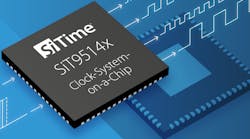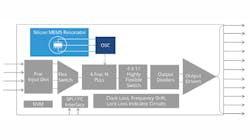MEMS Clock ICs and Oscillators Arrive in Time for 5G
Timing is everything in the fast-growing communications and enterprise markets, and SiTime has recently made two announcements that further solidify its place in the realm of timing devices that are so critical to infrastructure. The company’s Cascade SiT9514x family of MEMS clock ICs using its recently launched third-generation MEMS resonators that deliver higher performance with lower power. Meanwhile, the SiT9501 differential MEMS oscillators deliver high performance for 100G to 800G optical modules in a package as much as 50% smaller than quartz-based oscillators.
Cascade SiT9514x MEMS Clock ICs
Communications and enterprise electronics have previously used clock ICs with external quartz references to integrate multiple timing functions and to distribute clock signals. The all-silicon clock architecture in the SiT9514x devices provides more integration by integrating a MEMS resonator reference inside the package (see the figure). More importantly, with MEMS technology, the Cascade clock-system-on-a-chip delivers up to 10 times higher reliability and resilience, enabling the 5G vision of zero downtime. Either standalone or paired with the company’s MEMS TCXOs and OCXOs, the SiT9514x delivers a complete timing solution for applications such as 5G RRUs, small cells, edge computers, switches, and routers.
Listed below are the benefits of SiTime’s complete clock systems-on-a-chip:
· The devices’ integrated MEMS resonator eliminates issues with quartz such as capacitive mismatch, activity dips, susceptibility to shock, vibration, and EMI.
· Four independent PLLs, with maximum flexibility to support time synchronization applications where multiple independent clock domains are required
· Up to 11 outputs with an operating frequency range of 8 kHz to 2.1 GHz, as well as a 1-pps (pulse per second) output, for maximum frequency agility
· Programmable PLL loop bandwidth down to 1 milli-Hz for maximum filtering of wander or network noise in IEEE 1588 and synchronous Ethernet
· Fail-safe operation in case of input clock failures through faster hitless switching between four independent inputs. In such a situation, the device automatically switches to different input clock sources with minimum phase transient at the output, allowing the downstream PLL to remain locked, and the system to continue to operate reliably
· Excellent PSNR for highest performance in the presence of power supply noise
· Minimal external filtering circuits for simpler design, space savings, and BOM reduction
· Rich programmable features and configuration options: (1) Blank ISP (in-system programmable) devices provide maximum flexibility; (2) Pre-programmed devices enable system boot up without software configuration for maximum simplicity
· EVBs and TimeMaster software enable users to map clock configurations and generate the scripts for software integration, which speeds development
SiT9501 Differential MEMS Oscillators
In its SiT9501 differential MEMS oscillators, SiTime gives users space savings of up to 50% compared with quartz oscillators, enabling them to integrate more features and reduce the development time for optical modules, datacenter switches, telecom routers, edge servers, AI/graphics cards, and storage controllers.
In anticipation of massive Internet traffic growth, driven by 5G, AI, and cloud computing, data centers are increasing throughput. Optical modules and data communications equipment need to deliver faster data rates. Outdoor 5G infrastructure is subject to environmental stressors such as high temperatures, vibration, and airflow that can degrade throughput. With the increased data rates and potential environmental stressors, timing margins shrink, requiring lower jitter oscillators to ensure the same quality of service. In optical modules, a third of the PCB area is consumed by the optical sub-assembly, leaving little room for data processing electronics, and making small size a critical factor in oscillator selection. The SiT9501 differential oscillator solves both key issues by offering the lowest jitter in the presence of environmental stressors, and the smallest size.
The SiT9501 is the industry’s lowest-jitter programmable oscillator, and includes the following features:
· Popular networking frequencies from 25 MHz to 644.53125 MHz
· 70 femtoseconds of RMS phase jitter
· 2.0 x 1.6 mm package, as well as other industry-standard packages.
· Wide temperature range from -40 to +105°C
· On-chip voltage regulators to filter power-supply noise, enhancing power integrity for module designs
· FlexSwing driver reduces power consumption by 30% and integrates source-bias LVPECL resistors
The SiT9514x clock-system-on-a-chip family is sampling now. High volume production quantities will be available in Q4 2020. For more information, see jitter cleaners/networking synchronizers and clock generators.
The SiT9501 oscillator is sampling now. Production quantities are planned to be available in Q1 2021. Pricing is provided upon request, and a datasheet is available.
SiTime, www.sitime.com


